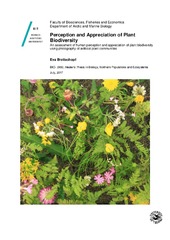Traditional plant functional groups explain variation in economic but not size‐related traits across the tundra biome
Permanent lenke
https://hdl.handle.net/10037/14894Dato
2018-11-16Type
Journal articleTidsskriftartikkel
Peer reviewed
Forfatter
Thomas, Haydn J.D.; Myers-Smith, Isla H.; Bjorkman, Anne D.; Elmendorf, Sarah C.; Blok, Daan; Cornelissen, Johannes H. C.; Forbes, Bruce C.; Hollister, Robert D.; Normand, Signe; Prevéy, Janet S.; Rixen, C; Schaepman-Strub, G; Wilmking, M; Wipf, S; Cornwell, W; Kattge, J; Goetz, SJ; Guay, KC; Alatalo, JM; Anadon-Rosell, A; Angers-Blondin, S; Berner, LT; Björk, RG; Buchwal, A; Buras, A; Carbognani, M; Christie, K; Siegwart Collier, L; Cooper, Elisabeth J.; Eskelinen, A; Frei, ER; Grau, O; Grogan, P; Hallinger, M; Heijman, MMPD; Hermanutz, L; Hudson, JMG; Hulber, K; Iturrate-Garcia, M; Iversen, CM; Jaroszynska, Francesca Orinda Holl; Johnstone, JF; Kaarlejärvi, E; Kulonen, A; Lamarque, LJ; Lévesque, E; Little, CJ; Michelsen, A; Milbau, A; Nabe-Nielsen, J; Nielsen, SS; Ninot, JM; Oberbauer, SF; Olofsson, J; Onipchenko, VG; Petraglia, A; Rumpf, SB; Semenchuk, Philipp; Soudzilovskaia, NA; Spasojevic, MJ; Speed, James David Mervyn; Tape, KD; Te Beest, M; Tomaselli, M; Trant, A; Treier, UA; Venn, S; Vowles, T; Weijers, S; Zamin, T; Atkin, OK; Bahn, M; Blonder, B; Campetella, G; Cerabolini, BEL; Chapin III, FS; Dainese, M; de Vries, FT; Díaz, S; Green, W; Jackson, R; Manning, P; Niinemets, Ü; Ozinga, WA; Penuelas, J; Reich, PB; Schamp, B; Sheremetev, S; van Bodegom, Peter MichielSammendrag
Aim - Plant functional groups are widely used in community ecology and earth system modelling to describe trait variation within and across plant communities. However, this approach rests on the assumption that functional groups explain a large proportion of trait variation among species. We test whether four commonly used plant functional groups represent variation in six ecologically important plant traits.
Location - Tundra biome.
Time period - Data collected between 1964 and 2016.
Major taxa studied - 295 tundra vascular plant species.
Methods - We compiled a database of six plant traits (plant height, leaf area, specific leaf area, leaf dry matter content, leaf nitrogen, seed mass) for tundra species. We examined the variation in species-level trait expression explained by four traditional functional groups (evergreen shrubs, deciduous shrubs, graminoids, forbs), and whether variation explained was dependent upon the traits included in analysis. We further compared the explanatory power and species composition of functional groups to alternative classifications generated using post hoc clustering of species-level traits.
Results - Traditional functional groups explained significant differences in trait expression, particularly amongst traits associated with resource economics, which were consistent across sites and at the biome scale. However, functional groups explained 19% of overall trait variation and poorly represented differences in traits associated with plant size. Post hoc classification of species did not correspond well with traditional functional groups, and explained twice as much variation in species-level trait expression.
Main conclusions - Traditional functional groups only coarsely represent variation in well‐measured traits within tundra plant communities, and better explain resource economic traits than size‐related traits. We recommend caution when using functional group approaches to predict tundra vegetation change, or ecosystem functions relating to plant size, such as albedo or carbon storage. We argue that alternative classifications or direct use of specific plant traits could provide new insights for ecological prediction and modelling.
Beskrivelse
Forlag
WileySitering
Thomas, H.J., Myers-Smith, I.H., Bjorkman, A.D., Elmendorf, S.C., Blok, D., Cornelissen, J.H.C., ... van Bodegom, P.M. (2019). Traditional plant functional groups explain variation in economic but not size‐related traits across the tundra biome. Global Ecology and Biogeography, 28, 78–95. https://doi.org/10.1111/geb.12783Metadata
Vis full innførselSamlinger
Relaterte innførsler
Viser innførsler relatert til tittel, forfatter og emneord.
-
Perception and Appreciation of Plant Biodiversity, An assessment of human perception and appreciation of plant biodiversity using photography of artificial plant communities
Breitschopf, Eva (Master thesis; Mastergradsoppgave, 2017-07-31)Anthropogenically caused global biodiversity declines and other human drivers point to the possibility of local plant diversity changes. The well-studied effects of local plant diversity on ecosystem processes implicate consequences to human well-being in the form of altered ecosystem services (including cultural services). Public awareness (knowledge and correct perception) about these changes ... -
Homesick plants - a study on Plant-soil feedback in home and foreign soil following a latitudinal sampling gradient from Morocco to Svalbard
Aares, Karoline Helene (Master thesis; Mastergradsoppgave, 2020-06-01)Plant-soil feedbacks receive increasing attention as impactors of plant performance and drivers of plant community composition. How plant-soil feedbacks act in introduction events regarding both native and foreign species is a topic requiring more research. In this aspect, two particular theories are of interest, Home-field advantage, and Enemy-release. The former predicts that plants perform best ... -
Plant-Soil Feedback: Alpine Grassland Plants in Home and Away soil
Priyadarshi, Ribha (Master thesis; Mastergradsoppgave, 2021-12-16)For the grassland, plant soil feedback (PSF) has been the focus of much recent research to understand plant species dynamics. Experimental methods are very important in the plant soil feedback (PSF) analysis, and it has been observed that various PSF experimental approaches yield in different feedback values. More field type experiments are required to understand the role of PSFs in plant communities ...


 English
English norsk
norsk


